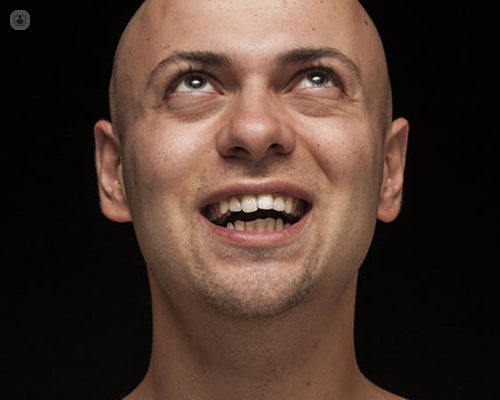Patchy hair loss: understanding alopecia
Written by:The exact cause of patchy hair loss, or alopecia areata, to use the medical term, remains unknown. Treatments are available, however, as Dr Aleksandar Godic, a leading dermatologist at The London Dermatology Centre explains.

What is alopecia areata?
Alopecia areata is a relatively common cause of hair loss, characterised by a sudden, patchy loss of hair. Alopecia tends to affect the scalp but hair loss can also occur at other sites, such as the beard, eyebrows, and eyelashes. In some cases, the condition can progress to complete loss of hair on the scalp (alopecia totalis) or even the entire body (alopecia universalis).
What causes alopecia areata?
The exact cause of alopecia areata remains unknown, but it is believed to be autoimmune. An intense inflammatory reaction involving hair follicles prevents hair from growing - the follicles do however remain partially preserved.
The condition is often associated with various other autoimmune conditions (underactive thyroid, anaemia, inflammatory bowel disease, allergies etc.) and half of patients with alopecia areata suffer from allergies and have nail pittings.
It is also thought that external factors can cause hair loss by triggering alopecia areata. Examples include; a sudden shock, extreme stress, physical trauma, local skin injury, infections, pregnancy, taking contraceptive pills or hormone replacement therapy, chemicals, seasonal changes, and chronic illness.
It also appears that alopecia areata may run in the family. Certain individuals may be genetically predisposed to developing the condition, with the actual onset of hair loss being triggered by environmental factors such as those mentioned above.
Can alopecia areata be treated?
Treatment for alopecia areata depends on the stage that hair loss has reached, with the best outcome achieved if the condition is treated as soon as possible after the onset. A dermatologist can determine the best treatment in each case. The prognosis is generally better for adults and patients who present a single, or a few, stable bald patches on the scalp.
In these cases, the first line treatment options for alopecia areata include;
- Minoxidil solution
- Steroid injections
- Topical steroids (creams and lotions)
- Light treatment
- Steroid and other immunosuppressant tablets
- Contact immunotherapy
- Platelet rich plasma (PRP)
The last of these treatments, PRP, is now approved by the Food and Drug Administration in the USA. Platelets are rich in growth factors – they can be obtained from a patient’s blood sample and subsequently injected into a patient’s bald spots. They release growth factors, which are anti-inflammatory, prolong the anagen phase of the hair cycle, and promote the survival of hair follicles. This leads to an increase in hair density, diameter, and quality. It has been established that PRP is superior to triamcinolone, which is a widely used first-line treatment option. Platelet-rich plasma is safe (there is no rejection reaction), efficient and cost effective.
Finally, it is worth noting that because the hair follicles remain intact, alopecia areata can go away on its own without any treatment.


